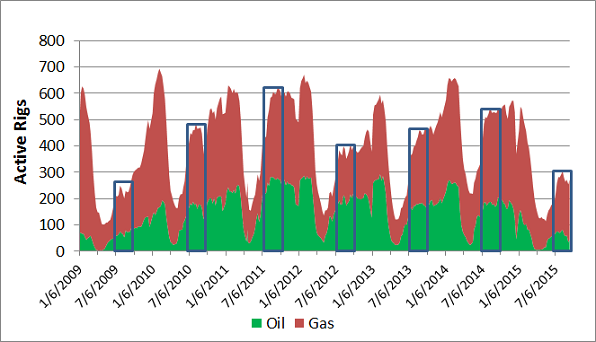Market Snapshot: Summer Rig Activity in Western Canada Reaches Lowest Level since 2009
Release date: 2015-10-21
The number of rigs drilling in western Canada typically ranges between 375 and 600 during the summer. 2015 summer rig activity averaged just 250, the lowest level since the financial crisis of 2009. The number of oil rigs fell from 168 in the summer of 2014 to 63 in the summer of 2015, a decline of 63 per cent, while the number of gas rigs fell from 294 to 188 in the same period, a decline of 36 per cent.
Rigs Drilling for Oil and Gas in Western Canada
Figure Source and Description
Source: JuneWarren-Nickle's
Description: This stacked cake chart shows the number of rigs drilling in western Canada from January 2009 to September 2015 on a weekly basis. It has two layers, one for oil rigs and one for gas rigs. Summer months are indicated by rectangles. Drilling has a seasonal pattern, with activity being highest in the winter when the ground is frozen before dropping sharply during the spring when the ground melts and provinces enforce road bans, making it difficult for rigs to get into the field. The summer of 2015 saw the lowest activity of any summer since 2009, with most of the decrease caused by the drop in oil drilling.
So far in 2015, oil prices have decreased to US$51/barrel, well below the US$93/barrel average between 2010 and the first half of 2014. During the same period, natural gas prices at Henry Hub in Louisiana remained consistently below US$3/MMBtu, averaging US$2.81/MMBtu. Gas prices in western Canada have trended even lower, averaging $2.62/GJ at NOVA Inventory Transfer (NIT).
Falling oil and gas prices stifle capital investment and cause reduced drilling activity, because of concerns that revenue from new wells may not cover the cost of drilling and operating them. Canada actually had the largest drop in rig activity (on a percentage basis) of any region in the world between 2014 and so far in 2015.
Although prices have decreased for both commodities, oil prices have fallen more than gas prices on an energy-equivalent basis, which led to the more pronounced drop in oil drilling. The number of gas rigs in western Canada is also supported by drilling for gas condensate, which is priced at a premium to light oil in western Canada because of demand for oil sands diluent. In addition, producers are interested in evaluating their gas resources for proposed LNG exports.
- Date modified:

